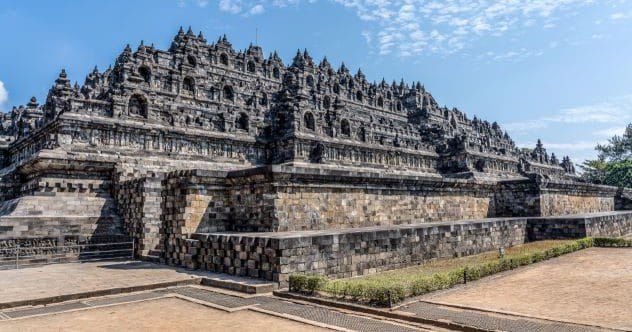Ancient monuments stand as silent witnesses to the ingenuity and cultural richness of past civilizations. These enduring structures, built for religious, cultural, or political reasons, offer invaluable insights into the societies that created them. From imposing pyramids to detailed temples, these monuments continue to inspire awe and connect us to history.
Their significance lies in their ability to bridge the gap between the present and the past, showcasing the remarkable achievements of human imagination and skill. This list highlights ten of the most stunning ancient monuments worldwide, each with its unique story and features. Whether you’re a history buff or simply appreciate architectural marvels, prepare to be captivated by these incredible sites.
Borobudur Temple
Located in Central Java, Indonesia, Borobudur Temple is a magnificent Buddhist monument built in the 9th century during the Sailendra dynasty. This massive structure features nine stacked platforms—six square and three circular—topped with a central dome. It stands as one of the greatest Buddhist monuments in the world.
Borobudur is adorned with over 2,600 relief panels and 504 Buddha statues, depicting scenes from Buddha’s life and Jataka tales. These reliefs serve as visual lessons for Buddhist followers. The intricate carvings and meticulous attention to detail make Borobudur an exceptional example of Mahayana Buddhist architecture.
Ajanta Caves
The Ajanta Caves, located in Maharashtra, India, represent some of the finest examples of ancient Indian rock-cut architecture. Carved between the 2nd century BC and the 6th century AD, these caves were once a secluded retreat for Buddhist monks, providing a serene space for meditation. After the decline of Buddhism in India, the caves were abandoned, only to be rediscovered in the 19th century.
Designated a UNESCO World Heritage site in 1983, the Ajanta Caves are celebrated for their elaborate sculptures and vibrant murals illustrating the life and teachings of Buddha. The caves, hewn from a horseshoe-shaped cliff along the Waghora River, feature interiors adorned with frescoes depicting Jataka tales and scenes from Buddha’s life, alongside impressive sculptures of Buddha, bodhisattvas, and other figures from Buddhist mythology.
Göbekli Tepe
Göbekli Tepe, situated in southeastern Turkey, is an extraordinary archaeological site dating back to the 10th millennium BC. This makes it one of the oldest monumental structures ever found. Discovered in 1963 but not thoroughly excavated until the 1990s, Göbekli Tepe predates the invention of agriculture, challenging conventional understanding of human history and the rise of civilization.
The site comprises large, circular stone structures built with massive, T-shaped pillars, some reaching up to 18 feet (5.5 meters) in height. These pillars are decorated with intricate carvings of animals and symbols that are still being deciphered. The monumental nature and detailed decoration of Göbekli Tepe suggest a more complex and advanced development of early human societies than previously thought.
Sigiriya
Sigiriya, or Lion Rock, is an ancient rock fortress in Sri Lanka’s northern Matale District. King Kashyapa I built it in the 5th century AD as a royal residence. Later, it became a Buddhist monastery until the 14th century. The history of Sigiriya is filled with drama, as King Kashyapa I seized power by murdering his father and brother. Today, it’s celebrated as one of the world’s most impressive ancient monuments.
Rising approximately 656.17 feet (200 meters) above the plains, Sigiriya features remarkable gateways and staircases leading to the fortress complex. It boasts stunning gardens, pools, and fountains. The wall paintings, found halfway up the rock face, depict beautiful maidens, animals, and religious symbols. Sigiriya offers a fascinating look into ancient Sri Lanka’s cultural and political landscape.
Persepolis
Persepolis, located in Iran, served as the capital of the Persian Empire during the Achaemenid dynasty from 550-330 BC. Darius I initiated its construction in 518 BC, a project that spanned 150 years. Persepolis was central to political, cultural, and ceremonial events, hosting important historical moments like the reception of tributes from various nations.
The monument displays impressive architecture and design, incorporating artistic styles from across the Persian Empire. Key structures include the Apadana Palace, the Throne Hall, and the Tachara Palace. Persepolis is famous for its detailed reliefs and sculptures portraying significant historical events and figures, symbolizing the power and influence of the Persian Empire.
Tiwanaku
Tiwanaku, also known as Tiahuanaco, was a major pre-Columbian civilization near Lake Titicaca in Bolivia. The city was likely established around 400 BC and peaked between AD 500 and 900. It served as an important cultural and religious hub for the Andean people. The Tiwanaku culture was celebrated for its exceptional architecture, engineering, and art, making it a prominent archaeological site in South America.
The city features monumental stone structures such as the Akapana pyramid, the Kalasasaya temple, and the Pumapunku complex. These structures were built using massive stone blocks transported from distant quarries. The architecture of Tiwanaku showcases intricate carvings, complex masonry techniques, and precise astronomical alignments.
Nan Madol
Nan Madol, located on the island of Pohnpei in Micronesia, comprises a series of complex stone structures. This monument is seen as a masterpiece of ancient engineering. The techniques used to construct Nan Madol and transport the massive stones—over 750,000 tons of black basalt—from faraway quarries remain a mystery. The islands were built using coral boulders and logs.
Nan Madol acted as the political and religious center for the Saudeleur dynasty, which ruled the region. It’s a significant example of ancient architecture and engineering, captivating visitors with its unique design. Recognized for its cultural and historical value, Nan Madol is a UNESCO World Heritage Site.
Chavin de Huantar
Chavin de Huantar is an ancient site in the highlands of Peru, built by the Chavin civilization between 900 BC and 200 BC. It served as a major religious and political center and is believed to have been the capital of the Chavin culture. Rediscovered in the early 20th century, it has become an important archaeological site in South America.
Chavin de Huantar is celebrated for its impressive architectural features, including underground chambers, carved stone sculptures, and intricate passageways. The site also features notable art, such as detailed stone carvings and ceramic artifacts. It offers valuable insight into the religious and cultural practices of the Chavin civilization, which greatly influenced subsequent Andean cultures. It is recognized as a UNESCO World Heritage Site.
Sukhothai Historical Park
Sukhothai Historical Park, a UNESCO World Heritage Site in Thailand, showcases the ruins of the Sukhothai Kingdom, a major early kingdom in the region. Founded in the 13th century, Sukhothai was a significant political and cultural center in Southeast Asia. The park includes the ancient capital city of Sukhothai and surrounding temples and monuments.
The park is known for its stunning architecture and intricate stone carvings that reflect the unique artistic style of the Sukhothai period. It houses over 193 ruins of temples, palaces, and other structures, all beautifully restored and preserved. These structures are distinguished by their lotus-bud-shaped stupas and detailed stone reliefs depicting scenes from the Buddha’s life. The park provides valuable insights into the artistic and architectural achievements of the Sukhothai Kingdom, attracting many tourists each year.
The Royal Tombs of Sipan
Discovered in Northern Peru in 1987 by archaeologist Walter Alva, the Royal Tombs of Sipan belong to the Moche civilization, which thrived between 100 BC and AD 800. The discovery is considered one of the most significant archaeological finds of the 20th century.
The tombs consist of chambers richly decorated with gold and silver artifacts, including jewelry, crowns, and ceremonial objects. The main tomb contains the remains of a Moche nobleman, likely a warrior-priest, surrounded by offerings such as pottery and textiles. One notable artifact is a necklace featuring a spider with a human face-like body and a warrior’s helmet, highlighting the connection between warfare and sacred power.
The Royal Tombs of Sipan are significant for their exceptional preservation of Moche culture, as well as their artistic and cultural importance. The site has yielded over thirteen royal tombs, making it the richest burial site in the Western Hemisphere. The tombs were found almost undisturbed. The Royal Tombs of Sipan are a UNESCO World Heritage Site and a popular tourist destination in Peru.
These ancient monuments offer a glimpse into the rich history and cultural achievements of civilizations past. Each site tells a unique story of human ingenuity, artistic expression, and societal development. From the towering temples of Southeast Asia to the mysterious ruins of South America, these landmarks stand as testaments to the enduring legacy of our ancestors.
Which of these ancient monuments sparks your curiosity the most? Share your thoughts and let’s discuss these amazing historical sites! Leave your comment below!










